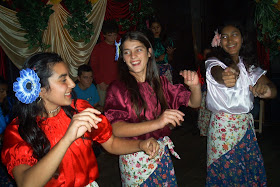


The Gypsy peoples originate from Sind region now in Pakistan.
Their Rom language is close to the older forms of Indian languages.
The three tribes of Rom, Sinti, and Kale probably left India after a succession of campaigns in Sind through the C11, initially spending time in Armenia and Persia, then moving into the Byzantine Empire after the Seljuk Turk attacks on Armenia.
Within the Byzantine Empire they dispersed into the Balkans reaching Wallachia (1385) and Moldavia (1370) ahead of this area falling to the Ottoman Turks. Other groups also moved through India to Gujarat and south of Delhi.
Gypsy populations can still be found along all these migration routes.
When entering west Europe they initially had letters of protection from the King of Hungary. This privileged situation did not last long as amazement at their way of life commonly led to hostilities. The Gypsy way of life still leads to hostilities from the people of their host nations.
Europeans regard "private property" as sacrosanct, whereas gypsies do not have a word for "possess", which gives rise to two incompatible ways of life and a continual problem of gypsies being regarded as "thieves" from the European's view.
In each host nation gypsies appear to take on the religion, names and language of their hosts, but within the Rom they maintain their Rom language, names, music, customs and Indian looks.
This tight community has meant that after some six hundred years there is still a large population of gypsies not integrated or assimilated with Romanians. From the time of their arrival in Romania Gypsies were the slaves of the landowners, only to be emancipated in 1851.
While in Romania some of the Gypsies took to speaking a version of Romanian called Bayesh which can be heard in some of the songs of Gypsy groups recorded in Hungary.
Nowadays about 40% of the Gypsies still speak Romany and many can still be seen travelling in lines of carts along the roads of Romania. The majority live in the towns and villages, some fully integrated into villages, some in large ornate houses standing out from the Romanians, but others in small buildings on scraps of lands on the villages edges.
The Rom tribes distinguish themselves by the names of their trades:
* Lăutari = musicians and dancers
* Căldărari (Kalderash) = Tin and coppersmiths
* Argintari = Jewellers
* Fierari = Blacksmiths
* Zlateri = gold panners
* Ghurara = sieve makers
* Lovar = horse dealers
Their Rom language is close to the older forms of Indian languages.
The three tribes of Rom, Sinti, and Kale probably left India after a succession of campaigns in Sind through the C11, initially spending time in Armenia and Persia, then moving into the Byzantine Empire after the Seljuk Turk attacks on Armenia.
Within the Byzantine Empire they dispersed into the Balkans reaching Wallachia (1385) and Moldavia (1370) ahead of this area falling to the Ottoman Turks. Other groups also moved through India to Gujarat and south of Delhi.
Gypsy populations can still be found along all these migration routes.
When entering west Europe they initially had letters of protection from the King of Hungary. This privileged situation did not last long as amazement at their way of life commonly led to hostilities. The Gypsy way of life still leads to hostilities from the people of their host nations.
Europeans regard "private property" as sacrosanct, whereas gypsies do not have a word for "possess", which gives rise to two incompatible ways of life and a continual problem of gypsies being regarded as "thieves" from the European's view.
In each host nation gypsies appear to take on the religion, names and language of their hosts, but within the Rom they maintain their Rom language, names, music, customs and Indian looks.
This tight community has meant that after some six hundred years there is still a large population of gypsies not integrated or assimilated with Romanians. From the time of their arrival in Romania Gypsies were the slaves of the landowners, only to be emancipated in 1851.
While in Romania some of the Gypsies took to speaking a version of Romanian called Bayesh which can be heard in some of the songs of Gypsy groups recorded in Hungary.
Nowadays about 40% of the Gypsies still speak Romany and many can still be seen travelling in lines of carts along the roads of Romania. The majority live in the towns and villages, some fully integrated into villages, some in large ornate houses standing out from the Romanians, but others in small buildings on scraps of lands on the villages edges.
The Rom tribes distinguish themselves by the names of their trades:
* Lăutari = musicians and dancers
* Căldărari (Kalderash) = Tin and coppersmiths
* Argintari = Jewellers
* Fierari = Blacksmiths
* Zlateri = gold panners
* Ghurara = sieve makers
* Lovar = horse dealers
Nice post. My mother used to tell me about the romani people. Near our native place, one related tribe are called the Lambadi people, in India they are also called Banjaras(meaning nomadic people who would sing and dance). She told me how people used to distrust them and that the romani people had light eyes, which later came to be associated with thievery. Fascinating people! Some tales say that it was the Romani people who brought music to Europe:p
ReplyDeleteps: Btw me and my friends are also big Manchester United Fans, probably that is how we came across your blog. Keep writing!
ManUnited Jai Ho!!
Great blog I enjoyed readingg
ReplyDelete